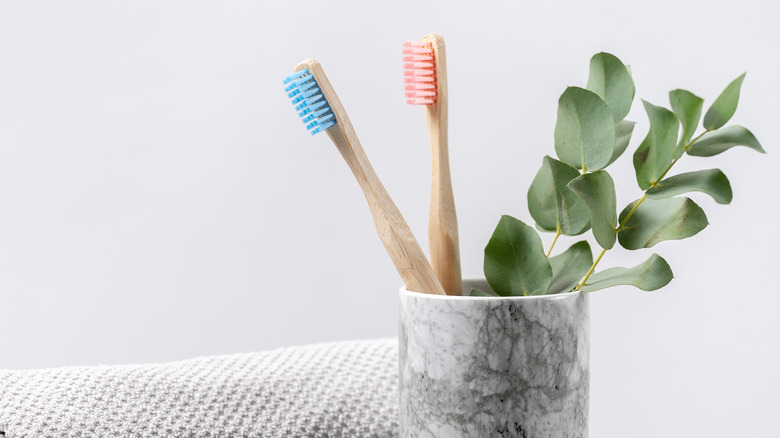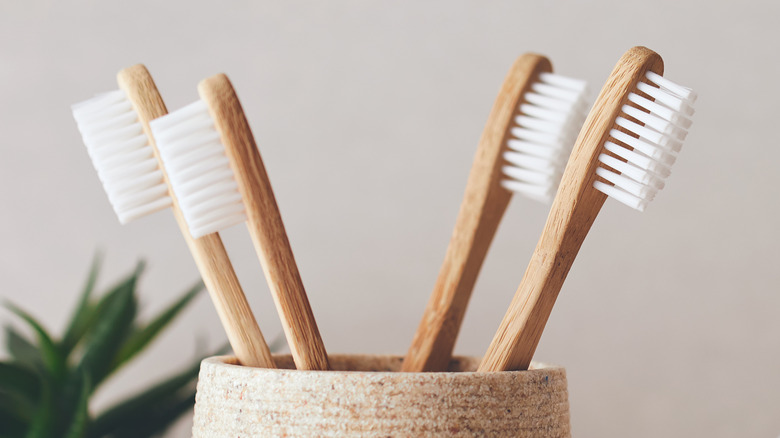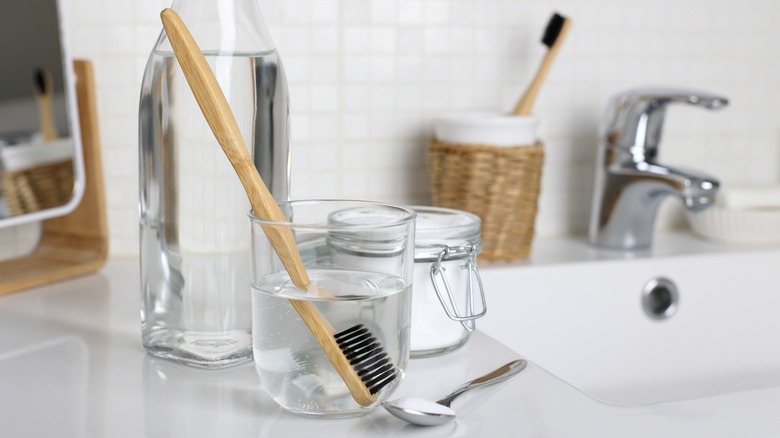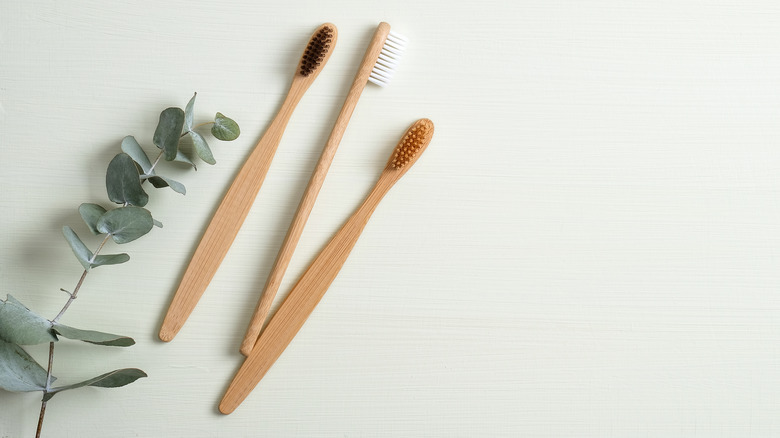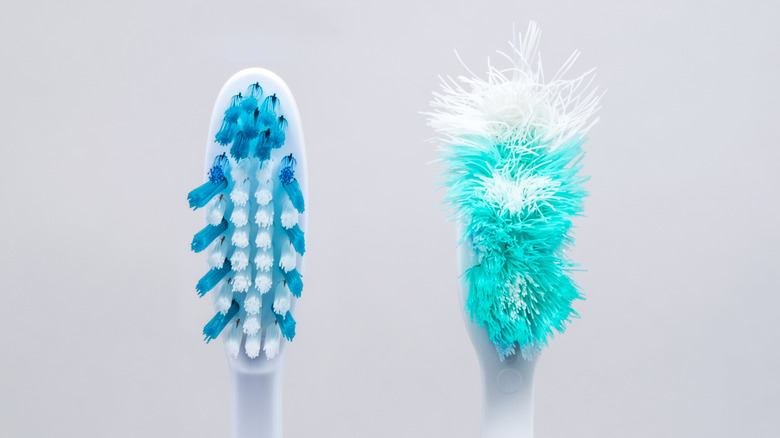How Often Should You Be Cleaning Your Toothbrush?
There are many items in your bathroom that require regular maintenance and cleaning -– from cleaning your bath mat to removing hard water stains and build up from your shower. One item that's often left out of cleaning to-do lists is the toothbrush. Toothbrushes should be cleaned regularly because they harbor several types of bacteria. This bacteria can come from your mouth or whenever someone flushes the toilet, and the aerosolized waste particles fall on the bristles of your brush, per the American Dental Association (ADA). Plus, your toothbrush is used multiple times a week, so it's bound to need a couple of cleanings before it's ready to be replaced.
The last thing you want is to brush your teeth with a dirty toothbrush since it can make your toothbrush less effective and hinder your oral health. Like other personal hygiene products, cleaning and disinfecting your toothbrush on a routine basis can ensure it's ready to be used. But, how often should you clean your toothbrush? Read through this guide from start to finish to find out when to clean your toothbrushes and how to properly maintain them.
When to clean your toothbrush
According to Dynamic Dental, it's important to clean your toothbrush once a week. While this may seem like another thing to add to your to-do list, it's important to thoroughly clean your toothbrush to prevent brushing with a dirty brush. After all, your toothbrush works hard to remove food stuck in your teeth, plaque build-up, and even clean your tongue. Plus, most people brush their teeth twice a day or more, so your toothbrush goes through a lot to help you maintain your oral health. You can also clean and disinfect your toothbrush daily if you prefer. Signs that indicate it may be time to clean your toothbrush include toothpaste build-up or if it's starting to smell. In many cases, you should clean your kids' toothbrush as often as you clean yours.
While your toothbrush can harbor bacteria if not cleaned, the ADA states that there's no evidence that suggests it can negatively impact your health. The Centers for Disease Control (CDC) also notes that there currently aren't any health concerns or issues related to using your toothbrush. The CDC also mentions that there's an insufficient amount of research on the subject. While the research on the effects of cleaning and disinfecting your toothbrush is limited, there's no harm in being cautious and cleaning your toothbrush with hydrogen peroxide, antiseptic mouthwash, or UV light devices. This can be especially beneficial since your toothbrush is often replaced every couple of months.
Tips for cleaning your toothbrush
Fortunately, there are many ways that you can clean your toothbrush between uses. This ensures that your toothbrush is ready to help you maintain your oral hygiene. One easy and affordable method to clean your toothbrush includes soaking it in hydrogen peroxide or antiseptic mouthwash. The ADA suggests individuals can soak their toothbrushes in 3% hydrogen peroxide to sanitize them, which is one way to use hydrogen peroxide in your home. You can also use a disinfecting mouthwash for this purpose. If you're planning on soaking your toothbrush in hydrogen peroxide or antiseptic mouthwash, make sure to only do it for 15 minutes. If you leave your toothbrush soaking for longer, it can permanently damage the bristles and make them less effective. You can also purchase a UV sanitizing device that's specifically designed to keep your toothbrush free of germs.
Germs can easily multiply in areas where there's a lot of moisture, so one huge tip is to let your toothbrush air dry (via the Insider). It's also important to wash your hands thoroughly before cleaning your toothbrush. This way, you can prevent transmitting excess germs to your toothbrush. Not doing so can impact the overall cleanliness of your toothbrush, and it may not be as clean as you think. Lastly, make sure to tackle the germiest place in your bathroom too, which is the toothbrush holder, before putting your clean toothbrush inside.
How to keep your toothbrush from getting as dirty
Besides regularly cleaning and disinfecting your toothbrush, it's also important to know how to maintain it as clean as possible, especially since most toothbrushes aren't replaced until three to four months after their first use. One of the biggest tips the ADA provides is not sharing your toothbrush with others, even if they're family members. This can cause bodily fluids, such as blood and saliva and other microorganisms you may have in your mouth, to be passed over to someone else.
The ADA also recommends individuals store their toothbrushes upright and let air dry instead of covering them with a plastic container. This is because the enclosed container can become a breeding ground for bacteria. However, you can use a container if you're traveling and must store it in your luggage. Just make sure the toothbrush is completely dry before placing it back inside a travel case.
When to throw away your toothbrush
According to the Cleveland Clinic, it's a good idea to throw away your toothbrush whenever you're sick. This is because the same bacteria that got you sick can continue to thrive on the bristles of your brush. Doing so can prevent you from becoming ill again or getting others sick if you share a toothbrush holder. The ADA also recommends you get rid of your toothbrush after three to four months of use. This recommendation also applies to powered toothbrush heads.
Keep in mind that you may need to throw out your brush sooner than the recommended time frame if the bristles are significantly frayed. Bristles that are visibly worn out can impact the effectiveness with which the brush cleans your teeth. Fortunately, toothbrushes are often inexpensive to purchase and can be found at a drug store near you. This makes it easy to replace your manual toothbrushes after a few months of use.
